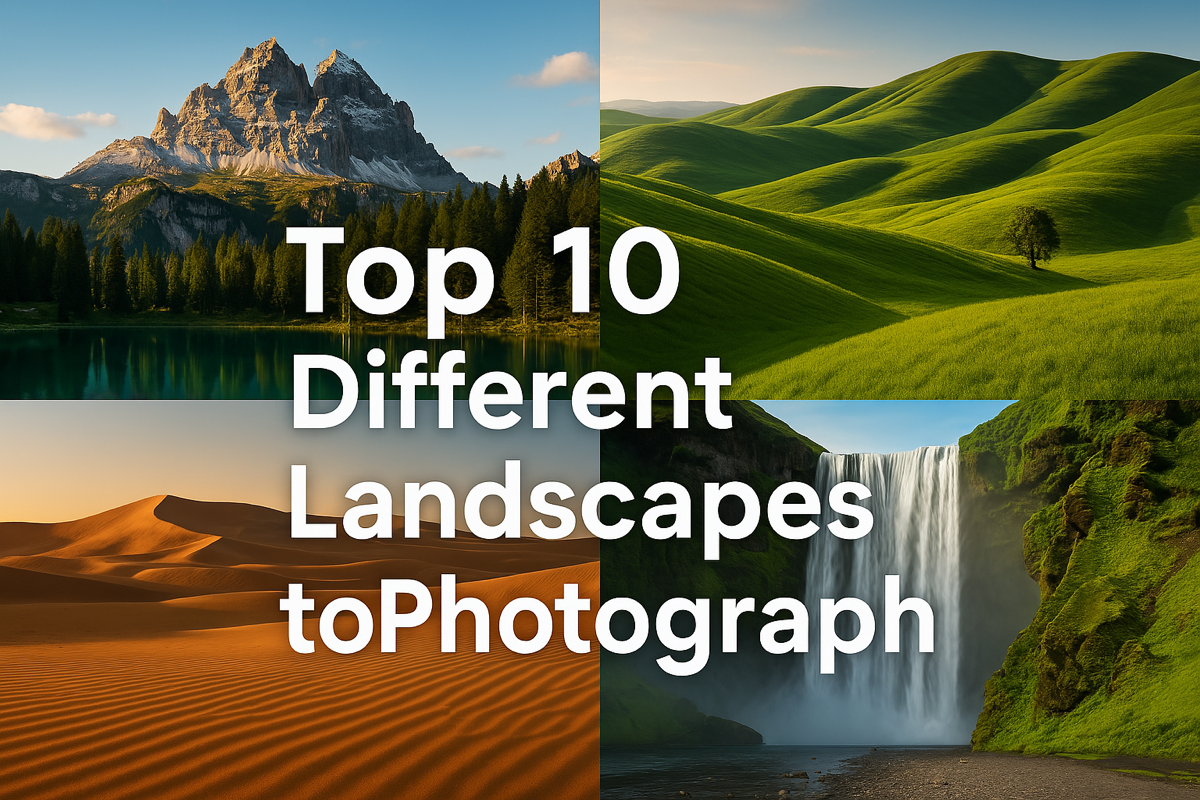Top 10 Different Landscapes to Photograph

Capturing the beauty of nature through a camera lens is one of the most rewarding experiences for photographers. From vast deserts to towering mountain ranges, the world is full of breathtaking natural scenery waiting to be photographed. Knowing the best landscapes to photograph can help you plan your next adventure. In this guide, we’ll explore the top 10 different landscapes to photograph, offering tips and insights on how to capture each one perfectly.
Why Photographers Love Capturing Landscapes
Landscape photography is a favorite among photographers for several reasons. First, it allows them to connect with nature, appreciating its vastness and beauty through their lenses. Unlike portrait or street photography, landscapes are ever-changing, offering different lighting, weather conditions, and seasonal variations that make every shot unique. Additionally, landscape photography provides an opportunity for creativity, enabling photographers to experiment with compositions, angles, and post-processing techniques. Many also find peace and solitude in capturing landscapes, as it often requires exploring remote and serene locations away from the hustle of city life. Finally, landscape photography helps document the beauty of our planet, preserving moments in time that can inspire others to explore and protect the natural world.
1. Majestic Mountains
Mountains are among the most photogenic landscapes in the world. Their towering peaks, dramatic lighting, and seasonal variations make them an exciting subject for photographers. Famous landscapes to photograph in this category include the Swiss Alps, the Rockies, and the Himalayas.
Photography Tips:
-
Use a wide-angle lens to capture the grandeur of the mountains.
-
Shoot during the golden hour for the best light and shadows.
-
Experiment with different perspectives, such as including foreground elements like trees or lakes.
-
Consider using a drone to capture aerial shots of mountain ranges.
-
Adjust your settings to compensate for bright snow or foggy conditions.
Best Mountain Locations for Photography:
-
The Dolomites, Italy – Known for their jagged peaks and picturesque villages.
-
Patagonia, Argentina & Chile – Stunning glaciers and dramatic peaks.
-
Mount Fuji, Japan – A perfect subject with seasonal beauty.
2. Serene Lakes
Lakes provide a calm and reflective element in photography. They often mirror the sky, creating stunning compositions. Some of the best places for landscape photography featuring lakes include Lake Bled in Slovenia, Lake Tahoe in the USA, and Lake Louise in Canada.
Photography Tips:
-
Look for reflections to add symmetry to your composition.
-
Capture lakes at sunrise or sunset for softer lighting and vibrant colors.
-
Use a tripod to ensure sharp images, especially when shooting long exposures.
-
Incorporate surrounding landscapes such as mountains or forests to frame the lake.
-
Experiment with polarizing filters to reduce glare and enhance colors.
Top Lakes for Photography:
-
Moraine Lake, Canada – Vibrant turquoise waters with snow-capped peaks.
-
Crater Lake, USA – Deep blue hues and incredible clarity.
-
Lake Baikal, Russia – The world's deepest lake, with frozen winter landscapes.
3. Rolling Hills and Countryside
Rolling hills and countryside offer a softer, more tranquil landscape for photography. Locations like Tuscany in Italy, the Palouse in Washington, and the English countryside are known for their iconic landscape photography spots.
Photography Tips:
-
Shoot during early morning or late evening to capture misty, dreamy effects.
-
Use leading lines such as winding roads or fences to create depth.
-
Capture seasonal changes for different moods and tones.
-
Consider drone photography to showcase the gentle curves of the land.
-
Experiment with contrast by including barns, cottages, or vineyards.
Top Countryside Photography Locations:
-
Tuscany, Italy – Golden fields and vineyards.
-
The Cotswolds, England – Rolling green hills and charming stone villages.
-
Provence, France – Lavender fields that bloom in summer.
4. Vast Deserts
Deserts are some of the most unique and challenging landscapes to photograph. The sand dunes, cracked earth, and dramatic skies make for compelling compositions. Famous desert locations include the Sahara, the Atacama, and the Mojave Desert.
Photography Tips:
-
Capture dunes in soft light to highlight textures and shadows.
-
Look for elements like lone trees or footprints to add scale.
-
Use a polarizing filter to deepen the sky’s blue and reduce glare.
-
Experiment with black and white photography for a dramatic effect.
-
Be aware of weather conditions like sandstorms, and protect your gear.
Best Deserts to Photograph:
-
Namib Desert, Namibia – Rolling dunes and unique dead-tree landscapes.
-
Wadi Rum, Jordan – Red rock formations and a Mars-like landscape.
-
Death Valley, USA – Diverse terrain with sand dunes and salt flats.
5. Lush Forests
Forests are full of mystery and depth, making them a favorite among nature photography locations. The Amazon Rainforest, the Redwood National Park, and Black Forest in Germany are prime locations for forest photography.
Photography Tips:
-
Look for foggy conditions to create a mystical effect.
-
Use a telephoto lens to isolate interesting details like moss-covered trees.
-
Experiment with slow shutter speeds to capture motion in leaves and streams.
-
Play with natural light filtering through the trees for contrast.
-
Capture wildlife interactions within the forest to add storytelling elements.
Best Forests for Photography:
-
Olympic National Park, USA – Rainforests with moss-covered trees.
-
Hoh Rainforest, USA – A green paradise with diverse flora.
-
Black Forest, Germany – Fairytale-like landscapes with dense woodlands.
6. Stunning Coastal Scenes
Coastlines provide an excellent mix of land and sea, offering some of the best landscapes to photograph. Cliffs, beaches, and ocean waves add dynamic elements to compositions. The Cliffs of Moher in Ireland, Big Sur in California, and the Amalfi Coast in Italy are top choices.
Photography Tips:
-
Use long exposures to create smooth water effects.
-
Capture waves crashing against rocks for a dramatic look.
-
Include human elements like surfers or boats to add scale and interest.
-
Consider shooting during stormy weather for dramatic lighting.
-
Frame shots with natural archways or rocky formations.
Best Coastal Locations:
-
Lofoten Islands, Norway – Rugged cliffs and stunning fjords.
-
Twelve Apostles, Australia – Towering limestone formations.
-
Reynisfjara, Iceland – Unique black sand beaches.
7. Frozen Landscapes
Ice and snow-covered landscapes offer a minimalist and ethereal look that’s truly captivating. Places like Antarctica, Iceland, and Alaska provide endless opportunities for winter photography.
Photography Tips:
-
Use a high exposure setting to capture bright snow without losing details.
-
Look for contrast, such as dark trees against white snow.
-
Dress warmly and use weather-sealed equipment to protect against cold conditions.
-
Experiment with ice caves and frozen waterfalls for unique compositions.
-
Try shooting the Northern Lights in Arctic locations.
Best Frozen Landscapes:
-
Jokulsarlon, Iceland – Icebergs floating in a glacial lagoon.
-
Banff National Park, Canada – Stunning frozen lakes and mountain backdrops.
-
Svalbard, Norway – Arctic wilderness with polar bears.
8. Volcanic Landscapes
Volcanic landscapes showcase the raw power of nature, with flowing lava, steaming vents, and rugged terrain. These dramatic environments offer some of the most intense and striking imagery.
Photography Tips:
-
Capture volcanic eruptions from a safe distance using a telephoto lens.
-
Experiment with long exposures to showcase flowing lava.
-
Highlight steam vents and geothermal features for dramatic effects.
-
Use natural light at sunrise or sunset for vibrant contrasts.
Best Volcanic Locations:
-
Mount Etna, Italy – One of the most active volcanoes in the world.
-
Big Island, Hawaii – Flowing lava and unique volcanic landscapes.
-
Mount Bromo, Indonesia – Otherworldly smoking craters.
9. Waterfalls
Waterfalls offer a dynamic and powerful subject, with cascading water creating breathtaking imagery. Whether large or small, waterfalls add movement and drama to landscape photography.
Photography Tips:
-
Use a slow shutter speed to create a silky water effect.
-
Frame waterfalls with surrounding rocks or greenery.
-
Capture waterfalls during overcast days to reduce glare and soften light.
Best Waterfall Locations:
-
Iguazu Falls, Argentina/Brazil – Immense power and lush scenery.
-
Plitvice Lakes, Croatia – Cascading falls in a stunning forest setting.
-
Skogafoss, Iceland – A dramatic waterfall with rainbows.
10. Urban Landscapes
Urban landscapes blend architecture, lights, and human activity to create vibrant and dynamic compositions. Cities offer endless opportunities for creative photography.
Photography Tips:
-
Capture city skylines during blue hour for stunning lights.
-
Use reflections from windows or puddles to add depth.
-
Experiment with leading lines in architecture.
Best Urban Photography Locations:
-
New York City, USA – Iconic skyscrapers and vibrant streets.
-
Paris, France – Classic architecture and charming streets.
-
Tokyo, Japan – Neon lights and futuristic cityscapes.
You Don’t Have to Travel Far to Capture Stunning Landscapes
While traveling to breathtaking locations around the world is a dream for many photographers, it's not a requirement for capturing stunning landscape photography. Beautiful landscapes can be found closer to home, whether it’s a nearby park, a countryside road, or even a cityscape at sunrise. Exploring your local area can reveal hidden gems, and practicing with these locations allows you to refine your skills before traveling further afield. Additionally, many of the same techniques used for photographing famous landscapes apply to local scenery, such as paying attention to lighting, composition, and seasonal changes. The key to great landscape photography isn't just the location—it’s how you see and capture the world around you.
Final Thoughts
From breathtaking natural scenery to iconic landscape photography spots, the world is filled with incredible places to capture. Whether you're looking for famous landscapes to photograph or hidden gems, these diverse landscapes offer endless creative opportunities. The key to mastering landscape photography is to plan ahead, experiment with different techniques, and embrace the beauty of nature in all its forms.
No matter which landscape calls to you, remember to respect nature, travel responsibly, and enjoy the adventure of capturing Earth’s stunning beauty. Happy shooting!



















